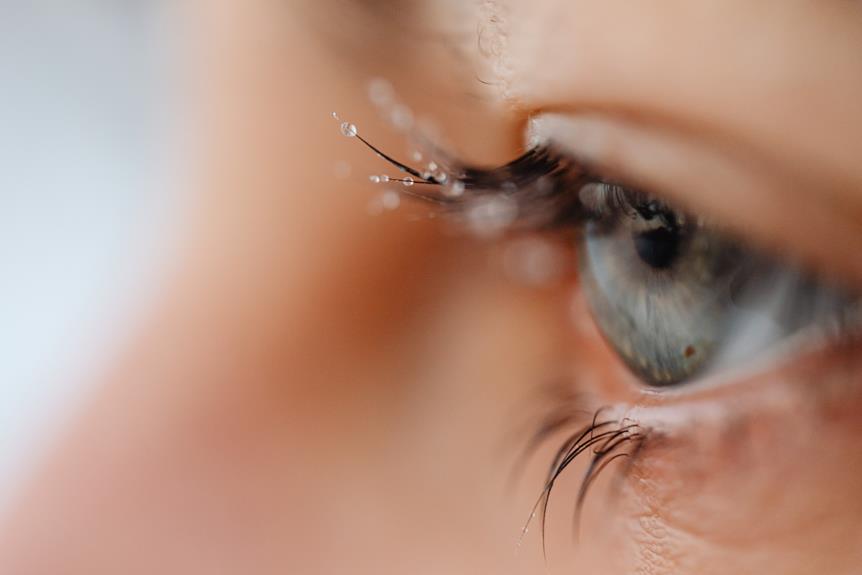Contaminated Eye Drops Blinds Patients: Lawsuits Pending
Alarming statistics reveal an increase in vision loss cases linked to the use of contaminated artificial tears. This article explores the unfolding legal landscape surrounding EzriCare and Delsam Pharma, whose products have been recalled following an outbreak of Pseudomonas aeruginosa infections. Victims may be eligible for compensation, and we urge those affected to understand their rights and potential case. We delve into the recall details, infection specifics, and the legal process, with special focus on lawsuitlegit.com's contingency-fee basis.

Background of Eye Drops Lawsuits
The unfolding saga of eye drops lawsuits began when attorneys started investigating potential legal actions on behalf of individuals who suffered vision loss after using contaminated artificial tears. These investigations focused on claims for compensation eligibility due to medical expenses, loss of income, and pain and suffering incurred as a result of using these faulty products. This raised questions about the adequacy of product safety measures and compliance with regulatory standards by manufacturers. Consequently, victims are now exploring legal representation options to ensure their rights are protected and to pursue justice. As these lawsuits progress, they highlight the crucial role of consumer protection laws and the importance of corporate responsibility in ensuring product safety.
Compensation From a Potential Lawsuit
In seeking justice, victims of the contaminated eye drops may be eligible for substantial compensation through a successful lawsuit. A key step towards this involves understanding the potential damages and eligibility requirements.
- Medical Expenses: The lawsuit can cover costs for treatment, surgery, medication, and future medical care.
- Lost Wages: If vision loss led to unemployment or reduced working hours, compensation for lost income is possible.
- Pain and Suffering: This includes compensation for physical pain, emotional distress, and loss of enjoyment in life.
- Punitive Damages: In cases of extreme negligence, the court may award additional damages to punish the responsible party.
Victims should consult with legal professionals to assess their individual circumstances and potential for compensation.
Details on the Recall
Responding to a multistate outbreak of Pseudomonas aeruginosa infections, authorities have called back all unexpired lots of EzriCare and Delsam Pharma Artificial Tears Lubricant Eye Drops. The recall impact is significant, affecting a wide range of individuals, from those who purchased the eye drops in retail outlets such as Walmart and Amazon.com, to patients who were administered these products during medical visits. The potential legal implications are also substantial. Manufacturers of contaminated batches may face lawsuits for medical expenses, pain and suffering, and loss of income among others. As the investigations continue, consumers and patients are advised to cease usage immediately and consult with legal professionals if they believe they have been affected.
Specifics of Contaminated Eye Drops
Amid the recall of EzriCare and Delsam Pharma Artificial Tears Lubricant Eye Drops, it's crucial to delve into the specifics of the contamination, which has resulted in severe vision loss for some users. The contamination is attributed to Pseudomonas aeruginosa, a drug-resistant bacteria prevalent in soil and water.
- The bacteria were detected in unexpired lots of the eye drops.
- Widespread use led to a multistate outbreak of infections, causing complications from the eye drops.
- Symptoms varied from blurry vision, redness, and sensitivity to light, to severe vision loss.
- The long term effects of contaminated eye drops included persistent vision issues, even blindness, in some users.
The FDA and CDC have since issued warnings against using these products.
Pseudomonas Aeruginosa Infections
Following the alarming revelations about the contaminated eye drops, it is essential to delve deeper into the nature of Pseudomonas Aeruginosa infections, the cause behind the severe vision loss experienced by some users. This bacterium is commonly found in soil and water, but it becomes dangerous when it contaminates medical products or facilities.
| Prevention strategies | Treatment options |
|---|---|
| Regular hand hygiene | Antibiotic therapy |
| Sterilization of medical equipment | Combination drug therapy |
| Use of personal protective equipment in healthcare settings | Surgical intervention, if necessary |
| Proper storage and handling of medical products | Supportive care (hydration, nutrition) |
| Immediate recall of contaminated products | Prompt medical attention |
The aforementioned strategies can help prevent and manage the infection, thus averting serious complications such as blindness.
Symptoms of Eye Infections
In the wake of understanding the severity of Pseudomonas Aeruginosa infections, it is crucial to recognize the symptoms of eye infections that may result from contaminated eye drops. These symptoms can often signify the onset of a Pseudomonas Aeruginosa infection and early detection is key for effective treatment.
- Redness or inflammation in the eye
- Pain or discomfort in the eye region
- Blurred vision or loss of vision
- Discharge from the eye
Prevention of eye infections includes regularly washing hands, avoiding contact with infected individuals, and refraining from sharing personal items like towels or cosmetics. Treatment options for Pseudomonas Aeruginosa infections vary but could include antibiotics or other prescribed medications from a healthcare professional.
The Increasing Antibiotic Resistance
The growing problem of antibiotic resistance complicates the treatment of Pseudomonas Aeruginosa infections, particularly those stemming from the use of contaminated eye drops. This issue poses an increasing public health risk and presents significant challenges in treatment.
| Antibiotic | Resistance Level | Impact on Treatment |
|---|---|---|
| Ciprofloxacin | High | Decreased Efficiency |
| Levofloxacin | Moderate | Potential Treatment Failure |
| Ceftazidime | Low | Possible Alternative |
| Tobramycin | Low | Possible Alternative |
| Colistin | Low | Last Resort |
The table illustrates the resistance levels of common antibiotics against Pseudomonas Aeruginosa and the corresponding impact on treatment strategies. As the bacteria's resistance to these antibiotics increases, it becomes more difficult to treat infections effectively, putting patients at risk of severe complications, such as blindness, from contaminated eye drops. Thus, addressing antibiotic resistance is crucial to safeguard public health.
Where Infections Commonly Occur
Despite the common association of Pseudomonas aeruginosa with soil and water, infections frequently occur within healthcare settings due to contamination of equipment, surfaces, and hands. This bacteria can create a host of problems, including serious eye infections.
- The use of contaminated eye drops can lead to severe infections, with potential long term effects on vision.
- Often, these infections are contracted in healthcare facilities where sterilization procedures have failed.
- Contaminated eye drops have led to outbreaks of Pseudomonas aeruginosa infections, with devastating consequences for patients.
- Preventing future outbreaks is crucial and requires stringent hygiene protocols and frequent testing of medical supplies.
It is essential that healthcare providers and patients alike are aware of these risks and take all necessary precautions to prevent further infections.
Process of Filing a Lawsuit
Transitioning from the risks of infections, a patient's legal journey often commences with the crucial step of filing a lawsuit against the responsible parties. This process of filing a lawsuit typically starts with a patient consulting with an experienced attorney. The lawyer then gathers critical facts and evidence, including medical records and personal testimonies. The next steps in a legal case involve drafting a complaint that outlines the allegations and damages, and filing it with the court. The legal team then engages with the defendants, negotiating for a possible settlement. If negotiations fail, the case proceeds to trial. Throughout this process, the patient's attorney is their advocate, guiding them through the complex legal landscape.
Gathering of Medical Documentation
In a significant number of these potential lawsuits, thorough collection and analysis of medical documentation serves as a critical aspect of the legal process. This meticulous process is aimed at building a strong evidentiary base that can support the plaintiff's claims.
- Medical records: These documents provide a detailed history of the patient's condition post exposure to the contaminated eye drops. It could include diagnosis reports, treatment plans, and prescriptions, which could directly link the use of eye drops to the resultant vision loss.
- Photos: Visual evidence of the eye condition could be compelling evidence.
- Statements from medical experts: These can help establish the causality between the use of contaminated eye drops and the patient's blindness.
- Receipts of purchases: These establish the plaintiff's use of the specific contaminated product.
Evidence collection, thus, is an integral part of these lawsuits.
The Legal Complaint and Process
Following the meticulous collection of evidence, the next stage in these potential lawsuits involves the filing of a legal complaint. This is a critical step in the legal complaint process, as it formally initiates a lawsuit. The complaint outlines the allegations against the defendants, substantiated by the collected evidence, and the damages sought as compensation for victims. Upon filing, it's served to the defendants, prompting their response. Subsequently, an iterative process of negotiations and court proceedings ensues, attempting to reach a settlement. If unsuccessful, a trial is likely. The end goal is to secure fair compensation for victims, covering medical expenses, loss of income, and pain and suffering, amongst others, resulting from the use of contaminated eye drops.
Class Action Vs Individual Lawsuits
While we have discussed the legal complaint process, it's also important to understand the distinction between class action and individual lawsuits in the context of this contamination issue.
- Class action lawsuits involve a group of people with similar injuries caused by the same product or action. The class action benefits include sharing legal costs and a combined strength in numbers.
- Individual lawsuits, on the other hand, are filed by one person. This approach may result in higher individual compensation, but it can also mean more responsibility for legal fees and proving your case.
In choosing between these two legal routes, one should consider the severity of their injury, the strength of their individual case, and their willingness to share any potential compensation.
Contingency-Fee Basis Explained
Although individual lawsuits might bear more financial risk than a class action suit, attorneys working with lawsuitlegit.com handle these cases on a contingency-fee basis, a concept that warrants further explanation. In a contingency-fee arrangement, the attorney's fees are contingent upon the outcome of the case. This means that the attorney only gets paid if the claimant wins the case or obtains a settlement. The fees are typically a predetermined percentage of the potential compensation awarded. This model provides access to the legal process for those who might not afford upfront attorney fees otherwise. It also aligns the attorney's interests with the client's, as the larger the compensation secured, the greater the attorney's fee will be. This arrangement is standard in personal injury cases, including these eye drop lawsuits.
How to Take Action
To initiate legal action against the manufacturers of the contaminated eye drops, potential claimants should first establish contact with lawsuitlegit.com by filling out an online form available on their website. This is the first step in understanding how to seek compensation for the potential long-term effects of this contamination.
- Research the recalled products: Knowing the specific items involved can help you determine if you have a valid claim.
- Gather medical records: These documents can provide evidence of your condition and its link to the contaminated product.
- Document any loss: This includes medical expenses, lost wages, and personal suffering.
- Consult with a lawyer: This can provide clarity about your rights and the potential worth of your claim.
Contacting lawsuitlegit.com for Help
In the midst of dealing with the devastating effects of contaminated eye drops, reaching out to lawsuitlegit.com can provide an essential first step towards seeking legal recourse and potential compensation. lawsuitlegit.com offers assistance on how to identify contaminated eye drops and explores legal options for compensation for those affected.
| Steps | Description | Emotion |
|---|---|---|
| Identifying Contaminated Eye Drops | lawsuitlegit.com provides information to help victims identify harmful products. | Empowerment |
| Exploring Legal Options | Victims can understand their rights and potential compensatory avenues. | Hope |
| Contacting lawsuitlegit.com | A simple online form starts the process towards legal recourse. | Relief |
| Seeking Compensation | Legal action could lead to compensation for medical bills, pain, suffering and more. | Justice |
Don't feel alone in your struggle. Take the first step and contact lawsuitlegit.com today.
Frequently Asked Questions
What Is the Shelf Life of Ezricare and Delsam Pharma Artificial Tears Lubricant Eye Drops?
The shelf life of EzriCare and Delsam Pharma Artificial Tears Lubricant Eye Drops is typically up to two years if stored correctly. The EzriCare storage conditions require a cool, dry place away from direct sunlight. Delsam Pharma's production standards also stipulate specific storage instructions to maintain product efficacy. However, it's crucial to always check the expiry date on the product packaging before use to ensure safety and effectiveness.
Are There Any Other Known Side Effects of Using These Contaminated Artificial Tears Apart From Vision Loss?
Apart from vision loss, contaminated artificial tears may cause a variety of other adverse effects, including eye pain, redness, discharge, increased light sensitivity, and the sensation of a foreign body in the eye. These symptoms are typically indicative of an eye infection. To prevent such issues, it's crucial to consider contamination prevention measures and explore alternative eye lubricants that have a proven safety record. Always consult with a healthcare professional for personalized advice.
How Long After Use of the Contaminated Eye Drops Do Symptoms Usually Begin to Appear?
In the context of Symptom Identification and Contamination Prevention, symptoms from the use of contaminated eye drops typically begin to appear within a few days to a week. These symptoms can include discharge, blurry vision, eye pain, redness, increased sensitivity to light, and a sensation of a foreign body in the eye. It is crucial to seek immediate medical attention if these symptoms develop, to prevent further complications.
Are There Any Specific Treatments or Therapies Recommended for Pseudomonas Aeruginosa Eye Infections?
Pseudomonas aeruginosa eye infections require immediate medical attention. Antibiotic eye drops are typically the first line of treatment, often in combination with systemic antibiotics. If the infection is severe, hospitalization may be necessary. Pseudomonas prevention methods include proper eye hygiene and avoiding contaminated water sources. In terms of alternative therapies, although some natural remedies may support overall eye health, they should not replace conventional medical treatment. Consult a healthcare professional for personalized advice.
How Can People Ensure the Safety of Other Eye Drops Products Before Using Them?
Consumers can ensure the safety of eye drop products by utilizing product verification methods, including checking the FDA's recall list and researching the manufacturer's reputation. It's also recommended to consult with healthcare providers for advice. Consideration of eye drop alternatives, such as preservative-free options or other treatments suggested by doctors, may provide additional safety. Always inspect the product for tampering, discoloration, or unusual sediment before use.

This post has been generated by AI and was not reviewed by editors. This is Not legal advice. Please consult with an attorney.




